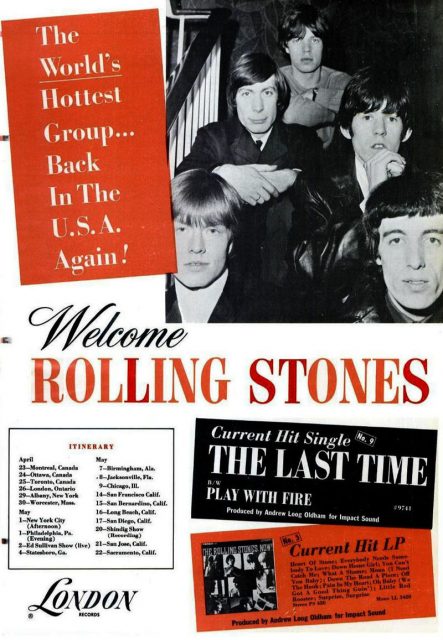What was the very first Rolling Stones song? Even Mick Jagger and Keith Richards can’t agree. When you’ve been musical partners for nearly 60 years, you’ll be forgiven if your memories of your early days together don’t exactly line up.
Mick and Keith knew each other as neighboring preteens in the early 1950s, when they attended the Wentworth Primary School, in Dartford, England, before Keith’s family moved away. As lads, they were both choirboys; Keith once sang at Westminster Abbey for Queen Elizabeth II. Jagger was the better student, winning a scholarship to study business at the London School of Economics. He also sang in a nascent rock band, Little Boy Blue and the Blue Boys. Richards was kicked out of a technical high school for truancy, had enrolled at Sidcup Art College, but spent more time in his room noodling around on his guitar, reconstructing Chuck Berry licks.
In the early 1960s, Jagger and Richards reconnected when they bumped into each other at a train station. Their conversation quickly turned to their shared admiration of such seminal rhythm and blues artists as Chuck Berry, Muddy Waters, and Little Richard. Soon they moved in together and started playing gigs at local pubs.
On July 12, 1962, Jagger and Richards along with mates Brian Jones, Dick Taylor, Ian Stewart, and Mick Avory played at the famed Marquee Club on London’s Oxford Street. They called themselves the Rollin’ Stones, after a favorite Muddy Waters song, and ran through a set list of covers, including songs by Waters, Chuck Berry, Fats Domino, Robert Johnson, all of whom would eventually influence the Stones’ original songwriting.

A young manager, Andrew Loog Oldham, only 19 at the time, advised Jagger and Richards to stop doing just covers and to write their own songs. And here their memories diverge.
Richards likes to recount that Andrew Oldham locked him and Jagger in a kitchen for a night and said, “Don’t come out without a song,” according to Keith: Standing in the Shadows, a 1996 Stanley Booth biography. “We sat around and came up with ‘As Tears Go By,’” Richards said. “It was unlike most Rolling Stones material, but that’s what happens when you write songs.” Richards went on to say that Oldham gave the song to Marianne Faithfull and it became a hit: “We were songwriters already! But it took the rest of the year to write a song for the Stones.”

Jagger remembers it differently, according to John McMillan’s Beatles vs. Stones and several biographers. “Keith likes to tell the story about the kitchen, God bless him,” Jagger said, explaining that an exasperated Oldham may have said “I should lock you in a room until you’ve written a song,” but that he didn’t mean it literally nor did it happen that way. Indeed, Jagger said their first song was actually “It Should Be You.”

The Rolling Stones’ first single was a Chuck Berry cover released in 1963, “Come On.” “The Last Time,” released in 1965, was the first original song written by Jagger and Richards to hit the Top Ten charts in the U.S. It ushered in a string of world-wide number-one hits memorable to this day, including “(I Can’t Get No) Satisfaction,” “Get Off of My Cloud,” and “Under My Thumb.” Richards’ jangly guitar and Jagger’s raw and edgy vocals led the British Invasion.

Quickly the Stones became superstars, with the facetious Jagger and Richards fashioning themselves as the Glimmer Twins. And nearly as quickly, the band saw the turmoil that accompanies sudden fame: drug troubles, internecine squabbles, artistic differences. Some say their creative run peaked in 1972 with the release of Exile on Main Street.
The Rolling Stones almost split permanently during the 1980s, during which time Jagger recorded a few solo albums. But he and Richards came to the conclusion that they had to reconcile for the simple reason that they were more successful together than apart.
“When we got to making [the 1983 record] Undercover, that was the worst time I’d ever experienced with them,” Chris Kimsey, who co-produced the album, told Vanity Fair’s Rich Cohen in 2016. “I would get Mick in the studio from like, midday until seven o’clock, then Keith from like, nine o’clock till five in the morning. They would not be together. They specifically avoided each other. Mick would say, ‘When’s he coming in? I’ll be there later.’ After about a week, it was killing me. And it was such silly things, like one would say, ‘What did he do?’ And I’d play a bit, and the other would say, ‘Get rid of it.’ ”

Much water has gone under the bridge since then, in the form of albums, movies, books, along with lineup changes, though Jagger and Richards remain as the beating heart of the band. The Rolling Stones were inducted into the Rock and Roll Hall of Fame in 1989.
They continue to perform sell-out arena shows, acting amiably enough on stage, if they go their separate ways post-show. In 2010, Richards published an acclaimed autobiography, Life, which includes memories Jagger disputes. But that’s how it goes with any 60-year relationship, right?
